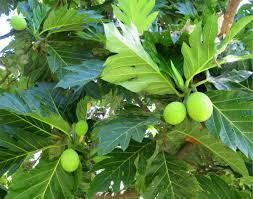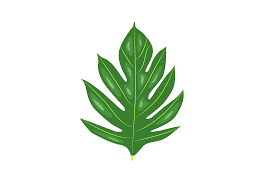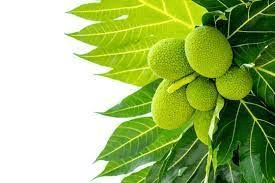Breadfruit leaves, stemming from the Artocarpus altilis tree, are versatile components with various practical and cultural uses. These broad, glossy leaves play a significant role in traditional practices and have garnered attention for their potential applications in modern contexts.
In traditional cultures, breadfruit leaves are utilized in culinary practices, where they serve as natural wraps for cooking and preserving food. The leaves impart a unique flavor and aroma to dishes while helping to retain moisture and enhance the cooking process. This traditional method of using leaves as cooking vessels reflects the resourcefulness and ingenuity of indigenous communities.
Beyond culinary uses, breadfruit leaves have been recognized for their medicinal properties in traditional medicine systems. Extracts from the leaves are believed to possess anti-inflammatory and antioxidant properties, making them valuable for treating various ailments and promoting overall health and well-being.
Moreover, breadfruit leaves have cultural significance in many societies, often featuring prominently in rituals, ceremonies, and artistic expressions. They are used in decorations, religious ceremonies, and as symbolic elements in cultural practices, representing fertility, abundance, and prosperity.
In modern contexts, breadfruit leaves are gaining attention for their potential applications in sustainable practices and innovative technologies. Research is underway to explore their use as eco-friendly packaging materials, biofuel feedstocks, and natural fibers for textiles.
These initiatives seek to harness the renewable and biodegradable properties of breadfruit leaves to address environmental challenges and promote sustainability.
Overall, breadfruit leaves are versatile resources with diverse applications and cultural significance. From their traditional uses in culinary and medicinal practices to their potential in modern innovations and sustainability efforts, breadfruit leaves continue to play a valuable role in various aspects of human life and society.
The Economic Importance and Uses of Breadfruit Leaves

1. Traditional Medicine: Breadfruit leaves have long been used in traditional medicine for their medicinal properties. They are believed to have antibacterial, anti-inflammatory, and antioxidant effects, used to treat various ailments such as wounds, skin conditions, and digestive issues.
2. Herbal Tea: Infusions made from breadfruit leaves are consumed as herbal tea, believed to have health benefits including immune-boosting properties and relaxation effects.
3. Livestock Feed: Breadfruit leaves are utilized as fodder for livestock, providing a nutritious source of food for animals such as goats, sheep, and rabbits.
4. Soil Improvement: Fallen breadfruit leaves decompose and enrich the soil with organic matter, improving soil structure, fertility, and moisture retention.
5. Cultural Significance: In some cultures, breadfruit leaves hold cultural and traditional significance, used in rituals, ceremonies, and crafts.
6. Shade and Shelter: Breadfruit trees with their broad leaves provide shade and shelter from the sun and rain, benefiting both humans and animals.
7. Erosion Control: Planting breadfruit trees with their dense foliage helps prevent soil erosion on slopes and riverbanks, contributing to environmental conservation.
8. Traditional Crafts: Breadfruit leaves are used in traditional crafts such as weaving, basket making, and roof thatching, supporting local artisanal industries.
9. Pest Control: Extracts from breadfruit leaves have pesticidal properties, used as natural insect repellents or insecticides in agriculture and household settings.
10. Income Generation: Selling breadfruit leaves for herbal tea production, crafts, or medicinal purposes can provide additional income for farmers and artisans.
11. Educational Purposes: Breadfruit leaves are used in educational programs and workshops to teach about traditional medicine, ecology, and cultural heritage.
12. Landscaping: Breadfruit trees with their lush foliage are planted for ornamental purposes in parks, gardens, and public spaces, enhancing aesthetics and biodiversity.
13. Firewood and Biomass: Dried breadfruit leaves are used as fuelwood for cooking and heating, or as biomass for energy production in biomass power plants.
14. Carbon Sequestration: Breadfruit trees absorb carbon dioxide from the atmosphere, helping mitigate climate change by sequestering carbon in their leaves and woody biomass.
15. Agroforestry: Intercropping breadfruit trees with other crops or fruit trees in agroforestry systems promotes biodiversity, soil conservation, and sustainable land use.
16. Traditional Dyes: Extracts from breadfruit leaves are used as natural dyes for textiles and crafts, providing eco-friendly alternatives to synthetic dyes.
17. Medicinal Research: Breadfruit leaves are studied for their potential medicinal properties in modern scientific research, exploring new therapeutic applications.
18. Culinary Uses: In some cultures, young breadfruit leaves are cooked and consumed as a vegetable, adding flavor and nutrients to dishes.
Read Also: Worm Infestation on Ruminant Animals: Symptoms and Treatment
The Products and By-products That Can Be Derived From Breadfruit Leaves

1. Herbal Tea: Dried breadfruit leaves are used to make herbal tea, enjoyed for its soothing and health-promoting properties.
2. Medicinal Extracts: Extracts from breadfruit leaves are processed into medicinal supplements, creams, and ointments for various health conditions.
3. Livestock Feed Supplement: Dried and powdered breadfruit leaves are added to livestock feed formulations to enhance nutrition and promote animal health.
4. Organic Fertilizer: Composting breadfruit leaves produces nutrient-rich organic fertilizer, beneficial for plant growth and soil fertility.
5. Artisanal Crafts: Breadfruit leaves are woven into mats, baskets, hats, and other handicrafts, showcasing traditional weaving techniques and cultural heritage.
6. Natural Pesticides: Extracts from breadfruit leaves are used as natural pesticides or insect repellents in organic farming and pest control.
7. Roof Thatching: Dried breadfruit leaves are used as thatch material for roofing traditional buildings and structures in some cultures.
8. Mulch: Chopped breadfruit leaves are used as mulch in gardening and agriculture to suppress weed growth, retain soil moisture, and add organic matter.
9. Aromatic Potpourri: Dried breadfruit leaves are infused with essential oils and used in potpourri mixtures for their pleasant aroma and decorative appeal.
10. Herbal Bath Soaks: Breadfruit leaf infusions are added to bathwater for their aromatic and skin-soothing properties, promoting relaxation and well-being.
11. Soil Erosion Control: Breadfruit leaves are used as ground cover or erosion control measures on slopes and embankments to stabilize soil and prevent erosion.
12. Natural Ink: Extracts from breadfruit leaves are used to make natural ink for calligraphy, painting, and artistic purposes.
13. Traditional Medicine: Fresh or dried breadfruit leaves are brewed into herbal concoctions for medicinal purposes, used to treat various ailments in traditional medicine systems.
14. Aromatherapy: Breadfruit leaf essential oils are used in aromatherapy practices for their calming and stress-relieving effects on the mind and body.
15. Culinary Wraps: Fresh breadfruit leaves are used as natural wraps for steaming or grilling food, imparting a subtle flavor and aroma to dishes.
16. Soil Conditioning: Decomposing breadfruit leaves enrich the soil with organic matter, improving soil structure, fertility, and microbial activity.
17. Eco-friendly Packaging: Breadfruit leaves are used as sustainable packaging materials for food items, reducing the environmental impact of plastic packaging.
Read Also: The Dates Corolla: Economic Importance, Uses, and By-Products
Frequently Asked Questions (FAQ’s) About Breadfruit Leaves

1. Are breadfruit leaves safe for consumption?
Yes, young breadfruit leaves are safe for consumption when cooked properly. However, mature leaves may be tough and fibrous and are not typically eaten.
2. How are breadfruit leaves used in traditional medicine?
Breadfruit leaves are brewed into herbal teas or extracts and used to treat various ailments such as wounds, skin conditions, digestive issues, and respiratory problems in traditional medicine practices.
3. Can breadfruit leaves be used as natural pesticides?
Yes, extracts from breadfruit leaves have pesticidal properties and can be used as natural pesticides or insect repellents in organic farming and pest control.
4. Are there any precautions to consider when using breadfruit leaves medicinally?
It is advisable to consult with a healthcare professional or herbalist before using breadfruit leaves medicinally, especially if pregnant, nursing, or taking medications, to avoid potential interactions or adverse effects.
5. How can breadfruit leaves contribute to soil improvement?
Breadfruit leaves decompose and enrich the soil with organic matter, improving soil structure, fertility, and moisture retention, making them beneficial for soil conditioning and composting.
6. Can breadfruit leaves be used as natural dyes?
Yes, extracts from breadfruit leaves are used as natural dyes for textiles and crafts, providing eco-friendly alternatives to synthetic dyes and showcasing traditional dyeing techniques.
7. Are there any environmental benefits of using breadfruit leaves?
Yes, utilizing breadfruit leaves for composting, soil conditioning, erosion control, and natural pest control promotes environmental sustainability and biodiversity conservation.
8. How can breadfruit leaves be utilized in culinary applications?
Fresh breadfruit leaves can be used as natural wraps for steaming or grilling food, imparting flavor and aroma. Additionally, young leaves can be cooked and consumed as a vegetable in some cultures.
9. Can breadfruit leaves be used in aromatherapy?
Yes, breadfruit leaf essential oils are used in aromatherapy practices for their calming and stress-relieving effects on the mind and body, promoting relaxation and well-being.
10. Are there any cultural or traditional uses of breadfruit leaves?
Yes, breadfruit leaves hold cultural and traditional significance in many societies, used in rituals, ceremonies, crafts, and culinary traditions, showcasing their importance in cultural heritage and identity.
Read Also: Everything You Need to Know About Moen Garbage Disposal
